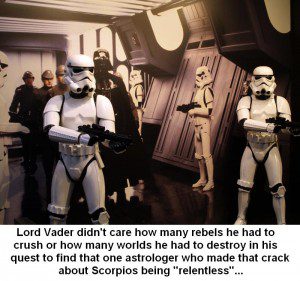 Who you are and what you’re like as a person all comes from the planetary placements in your birth chart. It isn’t just your Sun Sign: it’s your Moon and Mercury and Venus and Mars and so on. Each planet represents a different function of your personality, and the Sign placement puts a certain spin on them. For example, someone with Sun in Aries may be “bold,” but if that Aries has their Moon (which represents your basic emotional temperament) in Pisces, you have an Aries with a degree of softness and sensitivity you don’t normally see listed under the Sun Sign descriptions of “Aries.”
Who you are and what you’re like as a person all comes from the planetary placements in your birth chart. It isn’t just your Sun Sign: it’s your Moon and Mercury and Venus and Mars and so on. Each planet represents a different function of your personality, and the Sign placement puts a certain spin on them. For example, someone with Sun in Aries may be “bold,” but if that Aries has their Moon (which represents your basic emotional temperament) in Pisces, you have an Aries with a degree of softness and sensitivity you don’t normally see listed under the Sun Sign descriptions of “Aries.”
At least as important as the Sign placements are to how your planets work are the aspects between them. When planets are a certain number of degrees apart (give or take a few), they are said to “form an aspect.” The aspect colors the nature of the interaction between the two planets and affects how each planet involved functions. For example: Mercury rules how your mind works and how you communicate, and Mars rules your drives and temper. So if one sees a Mercury-Mars aspect in a birth chart, it will have something to say about how well that person thinks under pressure (or how likely they are to say something cutting when annoyed), depending on the type of aspect.
An aspect describes the relationship between two planets. And just like relationships between people, those can be both straightforward and complex all on the same day. I think I’ve found a metaphor that conveys this: my own long and complex relationship with one of the cornerstones of modern Western Civilization: the Stars Wars films.
***
Conjunctions: A New Hope
A conjunction is when two planets are less than ten degrees apart (the entire Zodiac being 360 degrees around). It represents a fusion of two different planetary energies for better and/or worse, and is (arguably) the most powerful of all astrological aspects. No matter what two planets are involved, a conjunction always makes itself felt somehow.
I was eleven years old when I sat in a dark theater waiting for the movie to begin. I had heard a few things, but had missed out on the big promotional push. But big-budget science fiction adventures were few and far between, so I sat and I waited. And the lights went down. And then a giant spaceship flew over the top of the screen and it was being shot at by a monster sized spaceship and then there was a terrible villain and robots and adventure and lightsabers and heroes and rebels and a Wookiee rescuing a Princess and pew pew pew and a space station the size of a moon and spaceships shooting at each other and pew pew pew and Use The Force Luke and holy cow!!
It was like finding religion, and it messed with my head in ways I still feel today.
Oppositions: The Empire Strikes Back
When two planets are about 180 degrees apart — on opposite sides of the sky from each other — they form an opposition. The opposition has a lot of the drama of a conjunction, but the two planets pull on each other rather than joining forces. They can make trouble, but like a pair of oxen tied together, when they work in tandem they can get amazing results.
I had to wait for what seemed like a lifetime for the next movie when it came out. There was no Death Star explosion in it, and in a lot of ways it was darker and perhaps less “fun” than the first film. But there was wisdom, and growth, and there was Yoda. We saw that actions (even those taken for the right reasons) can have bad consequences, and that being a real Hero sometimes means pain and sacrifice… but that sort of thing only makes Heroes more valuable.
It was both moving and deeply satisfying in a way a simple adventure story alone couldn’t be.
Trines: Return Of The Jedi
Trines are a separation of about 120 degrees, connecting two planets in Signs of the same element (Fire, Earth, Air, or Water). They make for a harmonious and happy connection, but without more effort they can seem a bit lazy. Trines are a bit like a meal with great taste but that somehow still manage to leave you hungry for something a bit different an hour after you’ve eaten it.
We went to the theater knowing there would be big screen adventure and the thrilling conclusion to a story that had dominated our imaginations for years. There were new wonders and new effects and new music. And yeah… the Ewoks were a bit on the dopey side and the pace was slightly off, but the conclusion worked and we all walked away sad that the story had ended, but knowing it had been a great ride.
Besides, despite any flaws, it was Star Wars, and Star Wars is awesome, right?
Squares: The Phantom Menace
Two planets that are 90 degrees apart in a birth chart form a “square.” They are at cross-purposes to each other. They boost and energize each other, but provide no mutual support. They aggravate and annoy each other, but in a compelling way. They aren’t stable or pretty, but they are an excellent source of drive and energy: if life was all trines, nothing would ever get done.
We had waited for years for the next Star Wars movie, and we were promised MORE adventure and BIGGER special effects and LOUDER pew pew pew than ever! The budget was HUGE! The cast was STELLAR! Everything about it ended with an exclamation point! But the dialogue sucked and it was at least 30 minutes too long and and even the good actors in it were wooden beyond words and Jar-Jar Binks was just plain stupid and annoying!
We were so let down and frustrated, we had to go see it again several times just to make sure we weren’t missing something.
Quincunxes: Attack Of The Clones
A quincunx (also called “the inconjunct”) is when two planets are about 150 degrees apart. They connect two planets in two Signs that have absolutely nothing in common with each other. Like a meal of something you can’t pronounce in a foreign restaurant, it may have its delights even if you can’t figure out exactly what it is. Astrologers traditionally group aspects into either “good” or “bad” and “major” or “minor” types, but the quicunx is inherently a head-scratcher that way. It has its charms, but it’s hard to figure out exactly what to do with the energies it produces.
Okay, so George Lucas actually took some outside advice this time, and the acting and dialogue were stiff (but not as bad), the action sequences seemed somewhat less pointless, and Yoda in a lightsaber duel was fun… as long as you ignored the fact that Yoda used to say things like “Wars do not make one great.” It didn’t exactly restore one’s faith in Star Wars entirely, but at least it wasn’t as horrible as “The Phantom Menace.”
Maybe that lack of compelling delights or flaws is why I only bothered to see it in the theater twice.
Sextiles: Revenge Of The Sith
A 60 degree separation between two planets is called a “sextile.” It’s sort of like a Trine Lite: it makes for harmonious blending of the energies of two planets without the obvious chemistry of a trine, but without the agitation caused by a square. Trines can be lazy, but a sextile can go completely un-noticed if you aren’t paying attention. It’s a bit like trying the World’s Best Pizza for the second time only to discover that this time around it has fewer toppings. It’s still pizza, and that’s not a bad thing at all.
There was a deliberate attempt in the look and style to make callbacks to the Original Trilogy… sometimes it worked, and sometimes it just reminded us of what we were missing. The dialog and acting was still stiff… but we realized that they had always had been that way (even in the better films of the series), and that sometimes that’s okay… or at least you can get away with it if the rest of the package is compelling. Mostly though, it was a pleasant relief from the last two films. And we finally got to see Darth Vader, even if it took half of forever for that damned whiny teenager to hurry up and die so it could happen.
Mostly we were just glad it was no “Phantom Menace,” and we still had our nostalgia for better times to fall back on.
***
These basic descriptions of how aspects in an individual birth chart work also apply to aspects between planets in your birth chart and planets in someone else’s chart, which is where “compatibility” comes in. For more on that, check out my ongoing series, “The Astrology Of Love And Compatibility.”


